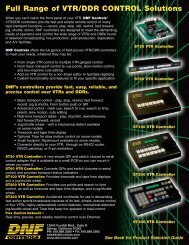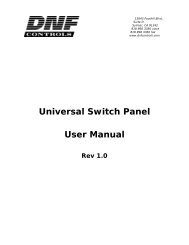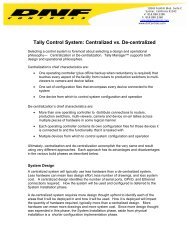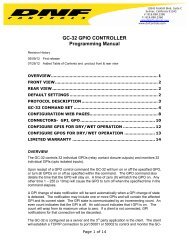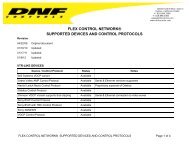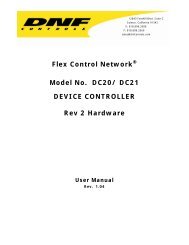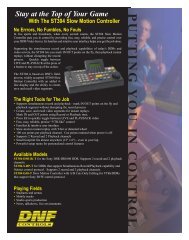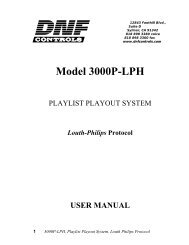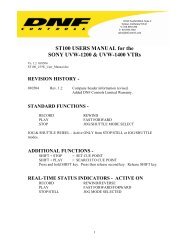2034CL-L-PBIO, Vs.3.0, 300 Clip Instant Access ... - DNF Controls
2034CL-L-PBIO, Vs.3.0, 300 Clip Instant Access ... - DNF Controls
2034CL-L-PBIO, Vs.3.0, 300 Clip Instant Access ... - DNF Controls
You also want an ePaper? Increase the reach of your titles
YUMPU automatically turns print PDFs into web optimized ePapers that Google loves.
REFERENCE . . . 2020. SETUP MENU 2021. FUNCTION TABLE 2322. SPECIFICATIONS 24ST<strong>300</strong> 24RS422 SERIAL CONNECTOR 24AUX PORT RS422 SERIAL CONNECTOR 24GPI IN/OUT CONNECTOR 25ST420 (SHOTBOX) 25RS422 SERIAL CONNECTOR 25POWER CONNECTOR 2523. TROUBLESHOOTING 26A. ST420 TROUBLESHOOTING 26B. VERSION 3.0 HARDWARE OF ST<strong>300</strong> ONLY 2624. KEY LAYOUT 2725. <strong>DNF</strong> CONTROLS LIMITED WARRANTY 28Manual Version.....................…............................... 1.5 020504Document ID............................... <strong>2034CL</strong>-L-<strong>PBIO</strong> User Manual3 <strong>2034CL</strong>-L, <strong>Vs.3.0</strong>, <strong>300</strong> <strong>Clip</strong> <strong>Instant</strong> <strong>Access</strong> System, Louth Protocol, <strong>PBIO</strong> Option
1. REVISION HISTORY070103 Rev. 1.1 Added Section CLEAR SINGLE CUEPOINT, and Key Layout.Added the following to SETUP MENU.CLIP SOMRECALL MODEVIDEO STANDARD110303 Rev. 1.2 Added <strong>DNF</strong> <strong>Controls</strong> Limited Warranty.Updated Receive Cue List & Transmit Cue List Function description.120903 Rev. 1.3 Added CREATING SUBCLIPS section.012204 Rev. 1.4 Changed Key Layout.020504 Rev. 1.5 Added note to cover and System Description: Supports up to 3 VideoServer Channels.4 <strong>2034CL</strong>-L, <strong>Vs.3.0</strong>, <strong>300</strong> <strong>Clip</strong> <strong>Instant</strong> <strong>Access</strong> System, Louth Protocol, <strong>PBIO</strong> Option
Getting Started . . .2. SYSTEM DESCRIPTIONNOW, production switchers can load & play video clips on Grass Valley GroupPROFILE and other video servers.Use the EMEM or SNAPSHOT Learn & Recall functions of the production switcher toload and play a video clip from a Recall or timeline.Use the Run and Trigger functions of the production switcher to Play, Stop or Recue thevideo clip. <strong>Instant</strong>ly load a video clip at the press of a button.<strong>Instant</strong>ly load a FILL clip & KEY clip at the press of ONE button, then play out bothchannels in sync.The <strong>300</strong> <strong>Clip</strong> <strong>Instant</strong> <strong>Access</strong> System consists of the ST<strong>300</strong>-SSM VTR Controller, STS420Shotbox and Shotlist Software.The ST<strong>300</strong> controls up to 3 video channels individually or ganged.SHOTLIST provides fast access to existing video clips stored on Grass Valley Group’s PROFILE,other DDR, VDR or Video Server supporting Louth Protocol.The SHOTLIST contains up to <strong>300</strong> CLIP IDs, stored in non-volatile memory in the ST<strong>300</strong>.Any clip in the SHOTLIST can be quickly loaded by simply entering the associated 3-digitnumber of its location, then pressing [LOAD]. Press [PLAY] to play the clip.Press [RECUE] to recue to the beginning of the clip or to the “recalled” time if defined.Upon receipt of the Learn command, the ST<strong>300</strong> saves the CLIP IDs of the currently loaded clips,the current time of each clip, the VTRs they are loaded on and the current GANG mode into theappropriate Cue Point.When the RECALL command is received, the ST<strong>300</strong> loads the learned <strong>Clip</strong>s onto the learnedVTRs, cues the <strong>Clip</strong>s to the learned time and restores the learned GANG mode.Learn & Recall may also be done directly from the ST<strong>300</strong>.DEFINITIONSThroughout this manual, VTR, DDR, VDR & Video Server will be referred to collectively as“Video Server.”The ST<strong>300</strong>-S/SM is referred to as the ST<strong>300</strong>.The ST420 SHOTBOX is referred to as “SHOTBOX.”SHOTKEY refers to the 1-30 switches on the SHOTBOX.Words surrounded by brackets, for example, [ENTER], are keys on the ST<strong>300</strong> or the SHOTBOX.[XXX] + [XXX] means hold the two keys down simultaneously.5 <strong>2034CL</strong>-L, <strong>Vs.3.0</strong>, <strong>300</strong> <strong>Clip</strong> <strong>Instant</strong> <strong>Access</strong> System, Louth Protocol, <strong>PBIO</strong> Option
3. SYSTEM INSTALLATIONa. SHOTBOX1) Plug one end of a standard 9-pin, RS422 serial cable into the OUTPUTconnector on the rear of the SHOTBOX. Plug the other end of thecable into the AUX connector on the rear of the ST<strong>300</strong>.2) Connect the 5 VDC, 1Amp POWER SUPPLY into the POWER connector onthe rear of the SHOTBOX. Plug the POWER SUPPLY into an outlet, 90 VACto 240 VAC.b. ST<strong>300</strong> CONTROLLER1) Plug one end of a 9-conductor, RS422 serial cable into the VTR 1 (2, 3 or 4)connector on the rear of the ST<strong>300</strong>. Plug the other end of the cable into the9-pin REMOTE connector on the Video Server.2) Connect the +5, +12, -12 VDC POWER SUPPLY into the POWER connectoron the rear of the ST<strong>300</strong>. Plug the Power Supply into an outlet, 90 VAC to 240VAC.3) Assign logical Louth ports to ST<strong>300</strong>’s VTR connectors.a) Press [MENU].b) Turn the Wheel until VTR Louth Address is displayed.c) Press VTR[1], VTR[2], or VTR[3] to select VTR.d) Assign a Louth Port address for that VTR 0-9. (0 turns that channelOFF.)e) The second line of the display will show “Input=Enter, Out=ESC”f) Press [ENTER] to select an Input Port.(A “-“ will appear in front of the selected number.)OR[ESC] to select an Out Port.g) Repeat steps c-f to assign a Louth Address to ALL VTRs you want touse.h) Press [ESC] to leave the MENU mode.4) Check the other options in the SETUP MENU prior to using the ST<strong>300</strong> toconfirm proper Record mode and other User settable modes.6 <strong>2034CL</strong>-L, <strong>Vs.3.0</strong>, <strong>300</strong> <strong>Clip</strong> <strong>Instant</strong> <strong>Access</strong> System, Louth Protocol, <strong>PBIO</strong> Option
c. PRODUCTION SWITCHER1) Connect a standard cable (RS422, 9-pin serial cable) to the supplied turnaroundadapter. Plug the turnaround adapter into the “VTR4” connector on the rear ofthe ST<strong>300</strong>. Connect the other end of the cable to the Peripheral Bus Connectoron the production switcher. (Communication Format- 38.4K, 8,1)2) To select a Production Switcher type (Default = Grass Valley Group).a) Press [MENU] and turn the Wheel until “SWITCHER” is displayed.b) Press Softkeys to toggle between Sony and Grass Valley.c) Press [ESC] at anytime to exit MENU mode.3) The ST<strong>300</strong> has 4 Peripheral Device Addresses, one for each VTR that itcontrols.To set the Device Address for each VTR:a) Press [MENU] and turn the wheel until “Peripheral Address” isdisplayed.b) Press VTR[1], VTR[2], VTR[3] or VTR[4] to select a VTR.c) Assign a Peripheral Device Address for that VTR, from 0 to 23, byentering the desired address using the numeric keypad.ORPress [DEL] to turn off the device.d) Select the next VTR and assign a Peripheral Device Address for it.e) When done, press [ESC] to exit MENU mode.4) Select Parity:a) Press [MENU] and turn the Wheel until “Parity” is displayed.b) Press Softkey to select ODD, EVEN or NONE parity to match thesettings on the Production Switcher.c) Press [ESC] to exit menu mode.5) Configure the production switcher:On the production switcher –Enable the Peripheral Bus.Enable the Peripheral Device Addresses assigned to the ST<strong>300</strong>.Enable the appropriate Learn/Recall levels.Enable the Timeline or Recall Trigger function.7 <strong>2034CL</strong>-L, <strong>Vs.3.0</strong>, <strong>300</strong> <strong>Clip</strong> <strong>Instant</strong> <strong>Access</strong> System, Louth Protocol, <strong>PBIO</strong> Option
Installation is complete.8 <strong>2034CL</strong>-L, <strong>Vs.3.0</strong>, <strong>300</strong> <strong>Clip</strong> <strong>Instant</strong> <strong>Access</strong> System, Louth Protocol, <strong>PBIO</strong> Option
4. VIDEO SERVER SETUPSelect LOUTH Broadcast communications protocol on the VIDEO SERVER to be controlled.If required, assign a serial port on the VIDEO SERVER through which the ST<strong>300</strong> will control it.NOTE: In LOUTH mode, the VIDEO SERVER ONLY allows Full Record.(INSERT and ASSEMBLE record modes are disabled.)Setup is complete.5. LOAD A CLIPa. Select a VTR by pressing VTR[1], VTR[2], or VTR[3].b. Press [CLIP LIST] to view the list of CLIP IDs that are resident on the Video Server.The CLIP LIST indicator will turn on.c. Press [LOAD] to create and load a new clip.(Creating a clip is described in “CREATE A CLIP,” Section 11.)ORTurn the Wheel to view the existing CLIP IDs on the video server.Turn the Wheel clockwise to scroll forward, or counter-clockwise to scroll backward,through the list of available CLIPs. Backward scrolling is limited to the last 10 CLIP IDsviewed.ORManually enter a clip ID using the ST<strong>300</strong> numeric keypad, or Shotbox Qwerty keyboard.d. Press [LOAD] to load the selected CLIP ID for playout.e. Locate the clip to the desired IN time.f. Repeat steps a-e until clips are loaded into the desired VTRs.g. Set the GANG mode, if required.9 <strong>2034CL</strong>-L, <strong>Vs.3.0</strong>, <strong>300</strong> <strong>Clip</strong> <strong>Instant</strong> <strong>Access</strong> System, Louth Protocol, <strong>PBIO</strong> Option
6. LEARN A CLIP OR CLIP COMBINATIONa. LEARN ON THE SHOTBOX1) Press [LEARN] on the ST420. The LEARN indicator will turn on.2) Select the desired BANK and ShotKey.3) The Learned CLIP ID will be displayed on the pressed key.NOTE: This will overwrite what you have assigned to the key previously.4) The ST<strong>300</strong> will remember the loaded clip(s), current time and gangconfiguration of the active VTR(s).5) Press [LEARN] to exit at any time.NOTE: The [LEARN] key toggles LEARN mode on/off.b. LEARN ON THE PRODUCTION SWITCHER1) On the ST<strong>300</strong>, load a clip(s) on the desired VTR(s). (See “LOAD A CLIP,”Section 5.)2) Select and enable the Peripheral Device Addresses for the ST<strong>300</strong>.3) Do a LEARN to the desired REGISTER.The ST<strong>300</strong> will save the VTR #, loaded CLIP ID and current IN time into theREGISTER number in the ST<strong>300</strong>.c. LEARN ON THE ST<strong>300</strong>1) Select the desired Cue Point by pressing [NEXT CUE], [LAST CUE] or bymanually entering the Cue Point using the numeric keypad.The selected Cue Point number is shown on the bottom line of the display.3) Press [SHIFT] + [MARK] to initiate the LEARN.The display will show:Select VTR:LEARN-LrnESC-Cancel4) Press the VTR key desired, [1], [2], [3].5) Press [MARK] and the ST<strong>300</strong> will:LEARN (save) the VTR Number (1,2,3), loaded CLIP ID and current IN time tothe selected Cue Point.10 <strong>2034CL</strong>-L, <strong>Vs.3.0</strong>, <strong>300</strong> <strong>Clip</strong> <strong>Instant</strong> <strong>Access</strong> System, Louth Protocol, <strong>PBIO</strong>Option
7. RECALLa. RECALL ON THE SHOTBOXSelect the desired Cue Point by pressing the BANK and ShotKey.The ST<strong>300</strong> will automatically load the Learned clips on the Learned VTRS, cue the clipsto the Learned time, then set the Learned GANG mode.b. RECALL ON THE PRODUCTION SWITCHERRecall the desired REGISTER NUMBER.The ST<strong>300</strong> will automatically load the Learned clips on the Learned VTRs, cue the clipsto the Learned time, then set the Learned GANG mode.c. RECALL ON THE ST<strong>300</strong>1) Select the desired Cue Point by pressing [NEXT CUE], [LAST CUE] or bymanually entering the Cue Point using the numeric keypad.The selected Cue Point number is shown on the bottom line of the display.2) Press [LOAD] on the ST<strong>300</strong>.The ST<strong>300</strong> will automatically load the Learned clips on the Learned VTRs, cuethe clips to the Learned time, then set the Learned GANG mode.8. SHOTBOX SHOTKEY MAPPING TO SHOTLISTLOCATIONSThe SWITCHES on the SHOTBOX access the SHOTLIST locations as follows:BANK 0, SWITCHES 1 30 access SHOTLIST locations 001 to 030.BANK 1, SWITCHES 1 30 access SHOTLIST locations 101 to 130.BANK 2, SWITCHES 1 30 access SHOTLIST locations 201 to 230.BANK 3, SWITCHES 1 30 access SHOTLIST locations 301 to 330.BANK 4, SWITCHES 1 50 access SHOTLIST locations 401 to 430.BANK 5, SWITCHES 1 30 access SHOTLIST locations 501 to 530.BANK 6, SWITCHES 1 30 access SHOTLIST locations 601 to 630.BANK 7, SWITCHES 1 30 access SHOTLIST locations 701 to 730.BANK 8, SWITCHES 1 30 access SHOTLIST locations 801 to 830.BANK 9, SWITCHES 1 30 access SHOTLIST locations 901 to 930.11 <strong>2034CL</strong>-L, <strong>Vs.3.0</strong>, <strong>300</strong> <strong>Clip</strong> <strong>Instant</strong> <strong>Access</strong> System, Louth Protocol, <strong>PBIO</strong>Option
9. <strong>PBIO</strong> REGISTER MAPPING TO SHOTLISTLOCATIONRegister 0-30 Cue Point 0-30Register 31-60 Cue Point 101-130Register 61-90 Cue Point 201-230Register 91-99 Cue Point 301-30910. TRIGGERThe operator fires a trigger using the Timeline or Run function on the production switcher. TheST<strong>300</strong> puts the Video Server into the following modes based on the trigger value:GRASS VALLEY GROUPTrigger ValueMode0 Play1 Recue to beginning of clip2 Slo-mo using ST<strong>300</strong> Preset Speed3 Reverse Play4 Still Frame5 Play6 Record7 or greater PlaySONYTrigger ValueMode0 Recue to beginning of clipPlay1 Play2 Slo-mo using ST<strong>300</strong> Preset Speed3 Reverse Play4 Still Frame5 Play6 Record7 or greater PlayTo control more than one VTR, enable the Peripheral Device Address for the required VTRs. TheTrigger will be sent to the enabled devices.ORGANG the required VTRs on the ST<strong>300</strong>. See the Menu Table for GANG instructions. Enable thePeripheral Device Address for one of the GANGed VTRs. The Trigger will be sent to the enabledVTR. The other VTRs in the GANG will perform the same action.12 <strong>2034CL</strong>-L, <strong>Vs.3.0</strong>, <strong>300</strong> <strong>Clip</strong> <strong>Instant</strong> <strong>Access</strong> System, Louth Protocol, <strong>PBIO</strong>Option
Advanced . . .11. CREATE A CLIPNOTE: New clips can be created ONLY if the INPUT Port is selected.a. SET THE RECORD DURATION1) Press [SHIFT] + [REC].2) The display shows current record duration. The second line of the displayshows “Enter Record Length” prompt.3) Enter the desired record duration using the ST<strong>300</strong>’s numeric keypad.4) Press [ENTER] to save the new record duration and exit.ORPress [ESC] to exit without saving.NOTE: Set Factory Defaults (in the SETUP MENU) sets the record duration to1 hour.b. CREATE A NEW NAME1) Press [CLIP LIST]. The CLIP LIST indicator turns on. The display will show“CREATE NEW CLIP.”2) Press [LOAD]. The display will show the default CLIP ID.3) Press [LOAD] to accept the default CLIP ID.ORUse [NEXT CUE], [LAST CUE] and Wheel to create a CLIP ID. Use the[NEXT CUE] and [LAST CUE] keys to position the cursor. Turn the Wheel toselect the desired letter.ORCreate an ID using the numeric keypad, with a maximum of eight characters ifextended IDs are OFF, and maximum of 20 characters if extended IDs are ON.Press [ENTER].4) Press [LOAD] to create the selected CLIP ID. If the selected CLIP ID alreadyexists, a warning message will be displayed. To load the existing clip, press[ENTER]. Press [ESC] to exit without loading the existing clip.13 <strong>2034CL</strong>-L, <strong>Vs.3.0</strong>, <strong>300</strong> <strong>Clip</strong> <strong>Instant</strong> <strong>Access</strong> System, Louth Protocol, <strong>PBIO</strong>Option
c. RECORD A CLIPNOTE: To record a clip, the video server must have enough memory to record the entireclip. Video input must be connected to the Record Channel.The ST<strong>300</strong> Port selected for recording must be an Input Port [a ”-“ (minus) number].1) Set the desired record duration as described in Section 11.a., “SET THERECORD DURATION.”2) Create a new name as described above in Section 11.b., “CREATE A NEWNAME.”3) Press [RECORD] to start recording.4) Press [STOP] to stop recording.14 <strong>2034CL</strong>-L, <strong>Vs.3.0</strong>, <strong>300</strong> <strong>Clip</strong> <strong>Instant</strong> <strong>Access</strong> System, Louth Protocol, <strong>PBIO</strong>Option
12. CREATING SUBCLIPSa. MARK IN (OUT) POINT1) Press [IN] ([OUT]) key.2) The current Timecode is saved as [IN] ([OUT]) point. IN ([OUT]) indicatorturns on.b. DELETE IN (OUT) POINT1) Press [DEL] key and [IN] ([OUT]) key2) The [IN] ([OUT]) point is cleared. The [IN] ([OUT]) indicator is turned off.c. MANUALLY ENTER IN (OUT) POINT1) Press [SHIFT] and [IN] ([OUT]) key.2) The display prompts to enter new [IN] ([OUT]) point3) Type in the new timecode using numeric keypad.4) Press [ENTER] to save the new [IN] ([OUT]) point.ORPress [ESC] to leave without savingORPress [RECUE] to save the new [IN] ([OUT]) point and recue to it.d. CREATE SUBCLIP1) Mark or Enter IN and OUT points as described above2) Press [SHIFT] + [CLIP LIST] keys.3) The display prompts to enter a subclip name.4) Enter the name using the Shotbox keyboard or the numeric keypad5) Press [ENTER].6) The subclip with the specified name and the IN and OUT points is created.15 <strong>2034CL</strong>-L, <strong>Vs.3.0</strong>, <strong>300</strong> <strong>Clip</strong> <strong>Instant</strong> <strong>Access</strong> System, Louth Protocol, <strong>PBIO</strong>Option
13. RECUE THE CURRENTLY LOADED CLIPa. Press [RECUE] to reload the currently loaded clip to the IN point.b. Press [SHIFT] + [RECUE].The display will show: “xx:xx:xx:xx”(Where xx:xx:xx:xx = Last entered RECUE time.)“Enter RECUE time”Enter the time using the ST<strong>300</strong>’s numeric keypad.Press [ENTER] to reload the currently loaded clip at the entered time.ORPress [ESC] to exit without searching.14. VIEW THE CLIP ID OF THE CURRENTLY LOADEDCLIPa. Press and hold [SHIFT], then press and release [LOAD].b. The bottom line will show: “Loaded <strong>Clip</strong>: xxxxxxxx”where xxxxxxxx is the CLIP ID.16 <strong>2034CL</strong>-L, <strong>Vs.3.0</strong>, <strong>300</strong> <strong>Clip</strong> <strong>Instant</strong> <strong>Access</strong> System, Louth Protocol, <strong>PBIO</strong>Option
15. VIEW CONTENT OF CUE POINTS ON THESHOTBOXa. Press [VIEW]. The VIEW indicator comes on.b. Press the switch for which you would like to see the content.c. The switch turns RED and the content (CLIP ID) of the corresponding Cue Point isdisplayed on a virtual display.For Example:VTR 1<strong>Clip</strong> 23VTR 2<strong>Clip</strong> 13VTR 3<strong>Clip</strong> 77VTR 4No AssignmentNote: All the remaining switches are not illuminated.d. Release the keys to return to normal operation.16. SHOTBOX CONTROL SWITCHESa. [PLAY]: Plays out the selected clip.b. [RECUE]: Returns to the beginning of the clip.c. [STOP]: Stops playout of the clip.17. CLEAR SINGLE CUEPOINTOn the Shotbox, press [SHIFT] + the Shotkey, the content of which you wish to clear.The Shotkey becomes blank, the corresponding cuepoint is cleared.17 <strong>2034CL</strong>-L, <strong>Vs.3.0</strong>, <strong>300</strong> <strong>Clip</strong> <strong>Instant</strong> <strong>Access</strong> System, Louth Protocol, <strong>PBIO</strong>Option
18. TRANSFERRING CUELISTSThe TRANSMIT CUELIST function allows you to transmit your list of Cue Points to a PC, usingthe provided utility software on the PC, or to another ST<strong>300</strong>. Transfer to a PC requires OpSuite3.0 software, which runs on a Windows-based computer. Contact <strong>DNF</strong> <strong>Controls</strong> for moreinformation.a. TO TRANSMIT CUE POINTS TO THE ST<strong>300</strong>1) Connect the VTR4 connector on the rear of the ST<strong>300</strong> to the VTR4 connector ofthe receiving ST<strong>300</strong> using an RS422 9-pin cable with TX and RX lines crossed.(A “turnaround” cable)2) Press [MENU].3) Scroll the Wheel until “Transmit CUE List? YES=Enter, Exit=ESC” isdisplayed.4) Press [ENTER] to start transmitting.The Display shows “Waiting to transmit” on the first line.5) When the Receiver is ready, transfer starts automatically.The Display now shows “Transmitting cuelist.”6) After the transfer is over, the display shows “Transfer is over” for one secondand then shows “Waiting to transmit” again.7) Connect another ST<strong>300</strong> to transmit the list again.ORPress [ESC] twice to exit the MENU mode.b. TO TRANSMIT CUE POINTS TO THE PC1) Connect the VTR4 connector on the back of the ST<strong>300</strong> to one of the COM portson the PC using a RS422 to RS232 adapter.2) Repeat steps 2-7 of the TO TRANSMIT CUE POINTS TO THE ST<strong>300</strong>section.18 <strong>2034CL</strong>-L, <strong>Vs.3.0</strong>, <strong>300</strong> <strong>Clip</strong> <strong>Instant</strong> <strong>Access</strong> System, Louth Protocol, <strong>PBIO</strong>Option
19. RECEIVE CUELIST FUNCTION.The RECEIVE CUELIST function allows you to receive your list of Cue Points from a PC orfrom another ST<strong>300</strong>. Transfer to a PC requires OpSuite 3.0 software, which runs on a Windowsbasedcomputer. Contact <strong>DNF</strong> <strong>Controls</strong> for more information.a. TO RECEIVE CUE POINTS FROM THE ST<strong>300</strong>1) Connect the VTR4 connector on the back of the ST<strong>300</strong> from the VTR4connector of the transmitting ST<strong>300</strong> using RS422 9-pin cable with TX and RXlines crossed.(A “Turnaround” Cable)2) Press [MENU].3) Scroll the Wheel until “Receive CUE List? YES=Enter, Exit=ESC” is displayed.4) Press [ENTER] to start receiving.The Display shows “Waiting to receive” on the first line.5) When the Transmitter is ready, transfer starts automatically.The Display now shows “Receiving cuelist.”6) After the transfer is over the display shows “Done-Success! Press any key…”7) Press any key. The display shows “Receive cuelist?” message.8) Press [ESC] to exit the MENU mode.b. TO RECEIVE CUE POINTS FROM THE PC1) Connect the VTR4 connector on the back of the ST<strong>300</strong> to one of the COM portson the PC using RS422 to RS232 adapter.2) Repeat steps 2-8 of the TO RECEIVE CUE POINTS FROM THE ST<strong>300</strong>section.19 <strong>2034CL</strong>-L, <strong>Vs.3.0</strong>, <strong>300</strong> <strong>Clip</strong> <strong>Instant</strong> <strong>Access</strong> System, Louth Protocol, <strong>PBIO</strong>Option
Reference . . .20. SETUP MENUPress [MENU]. The MENU indicator will turn on.Turn the Wheel to select item to change.Press [MENU] OR use the Softkeys to change the desired mode for that option.Turn the Wheel at anytime to select another item.Press [ESC] at anytime to exit. The MENU indicator will turn off.MENU MODESSET LOUTHPORTRECORD(Turning Wheel clockwise)Allows user to select Louth Port for each VTR.Press [MENU] to select the desired record mode: Lockout or Crash (Full).EXTENDED IDs(V3.0 Only)CLIP SOMToggle Extended IDs ON/OFF.Extended IDs ON allows access up to 32 characters, OFF – up to 8 characters.Press displayed softkey to toggle between “ZERO” and “NOT ZERO.”Select ZERO if the clips that you are using start with 00:00:00:00.Select NOT ZERO if the clips that you are using do not start with 00:00:00:00.RECALL MODEPress Normal or Redirect (Redir).When one and only one clip is learned into a Cue Point, the <strong>Clip</strong> will beREDIRECTED to load on the currently selected VTR if REDIR is on.If REDIR is off, the <strong>Clip</strong> will be loaded on the VTR it is LEARNED into.VIDEO STANDARDWIND MODEPress displayed softkey to select PAL, NTSC (not drop frame), or DF (dropframe).Press Softkey to select:HOLD(Fast wind is maintained only while key is depressed.)ORLATCH(Fast wind is initiated and maintained with momentary key press.)Select fast wind speed (3.9 to 23.7) by pressing Softkey below SPD.20 <strong>2034CL</strong>-L, <strong>Vs.3.0</strong>, <strong>300</strong> <strong>Clip</strong> <strong>Instant</strong> <strong>Access</strong> System, Louth Protocol, <strong>PBIO</strong>Option
SLOMOST<strong>300</strong> display shows(Non T-Bar Version):SLOMO with: WHEELSpdRange PresetPress Softkey [SPEED] to select SLOMO speed ranges:Press Softkey to select: 0 +200% OR -100 +200%.NOTE: 100% is normal speed.Press Softkey [BACK] to return to SLOMO MENU.Press [ESC] to exit SETUP MENU and save changes.ORTurn the Wheel to select another item.ST<strong>300</strong> display shows(T-Bar Version):SLOMO with: TBARWHEELPress Softkey [TBAR] (or [WHEEL]) to toggle between them.The T-BAR has a speed range of 0 +200 with a detent at +100% play speedOR a range of 0 +100% (detent at +100% Play speed).NOTE: 100% is normal speed.For Wheel only:Press Softkey [PRSET] to select the SLOMO Preset Speed Mode.Press Softkey [UPDATE].When exiting SLOMO mode, the last used speed is saved in the Preset Speedregister.Press Softkey [STATIC].The Preset Speed register is NOT updated when exiting SLOMO mode.It is only changed by [SHIFT] + [SLOMO] (PRESET SLOMO).ST<strong>300</strong> SETUPST<strong>300</strong> SETUPClear CuesSetDefaultPress Softkey beneath ClearCues to clear all Cue Points to 00:00:00:00.Press Softkey [YES] when asked “Are You Sure?”Press Softkey beneath SetDefault to set ST<strong>300</strong> to default settings.Press Softkey [YES] when asked “Are You Sure?”DISPLAYSOFTWAREVERSIONThe version number for the currently installed software is displayed.21 <strong>2034CL</strong>-L, <strong>Vs.3.0</strong>, <strong>300</strong> <strong>Clip</strong> <strong>Instant</strong> <strong>Access</strong> System, Louth Protocol, <strong>PBIO</strong>Option
SYNC ON/OFFRECORD<strong>PBIO</strong> ADDRESSFor V3.0 only. Set video sync to ON/OFF.Press Softkey to select single button or 2-button record.RECORD = [REC] Only OR [REC] + [PLAY].Press VTR key to assign <strong>PBIO</strong> address.Display shows:<strong>PBIO</strong> Address = 00Enter 00-23Enter address number desired on numeric keypad. Repeat for all VTRs assigned.SWITCHERTYPEPARITYPREROLLTRANSMITCUELISTRECEIVECUELISTSelect your switcher type: GVG = Grass Valley Group (default) or Sony.For Phillips DD35 with PBus, use GVG.Select ODD, EVEN or NONE. This is the parity sent via the Peripheral Bus(<strong>PBIO</strong>) to the ST<strong>300</strong>.Enter Preroll value.Transmits Cuelist to another ST<strong>300</strong> or to a PC.Receives Cuelist from another ST<strong>300</strong> or a PC.22 <strong>2034CL</strong>-L, <strong>Vs.3.0</strong>, <strong>300</strong> <strong>Clip</strong> <strong>Instant</strong> <strong>Access</strong> System, Louth Protocol, <strong>PBIO</strong>Option
21. FUNCTION TABLEFunction Key Press DescriptionGOTOENTERED TIME[SHIFT] + [RECUE]Search the VTR to the manually entered time.Use the ST<strong>300</strong> numeric keypad. Press [ENTER] or [RECUE].NOTE: Use 00:00:00:00 to recue a clip to ET=0 if start time isnot ET=0GANG [SHIFT] + [VTR #1]OR[SHIFT] + [VTR #2]OR[SHIFT] + [VTR #3]Individually press the VTR keys to be included in the gang. TheLED above the key will turn on. Press the VTR key again toremove from gang, the LED above the key will turn off. Press[ESC] to exit.The VTR LEDs that are on show the gang.The flashing LED shows which VTR is currently selected.FFWD [FFWD] Press and HOLD to shuttle. Release key to stop. Set WINDSpeed in MENU.JOG [JOG] Select JOG mode and enable Wheel.LAST CUE [LAST CUE] Step to the previous Cue Point Location.NEXT CUE [NEXT CUE] Step to the next Cue Point Location.RECORD [REC] Places VTR into the Record mode selected by RECORD MODEin the SETUP MENU. Press [RECORD] OR [RECORD] +[PLAY].REWIND [RWD] Press and HOLD to shuttle. Release key to stop. Set WINDSpeed in MENU.SHUTTLE [SHUTTLE] Select SHUTTLE mode and enable Wheel.SLOMO [SLOMO] Press [SLOMO] to slo-mo the VTR. Turn the Wheel (or movethe T-Bar, if available) to change the play speed.Press [SLOMO] to STILL frame.OR Press any transport key to exit SLOMO.SLO-MO SPEEDPRESET[SHIFT] + [SLOMO]For WHEEL ONLY: Press [SHIFT] + [SLOMO] to preset theslo-mo speed. Turn the Wheel to select desired speed.Press [ESC] or any transport key to exit.STOP [STOP] Press once to STILL frame VTR.Press again to put VTR into STOP mode.TIME MODESELECT[TIME MODE]Press to toggle between ET (Elapsed Time) andRT (Running Time) display modes.23 <strong>2034CL</strong>-L, <strong>Vs.3.0</strong>, <strong>300</strong> <strong>Clip</strong> <strong>Instant</strong> <strong>Access</strong> System, Louth Protocol, <strong>PBIO</strong>Option
22. SPECIFICATIONSST<strong>300</strong>Power:Size:Weight:Rear Panel Connectors:Display:Jog/Shuttle Wheel:Optional “T”-bar:90 VAC to 265 VAC adapter supplied with IEC connector(L” x W” x H”) 10 1/2” x 6” x 1 1/2” (front) 3.0” (rear)(-T Bar Version) (L” x W” x H”) 12 5/8” x 6” x 1 1/2” (front) 3.0”(rear)4 lbs.VTR1, VTR2, VTR3, VTR4 ..…. All DB9FGPI.......................................…..... DBF15FPower ...................................…..... DB9MAux .................... ...................…... DB9FEasy to read 2-line, back-lit LCD display(User adjustable contrast)With mechanical detents.Slo-mo 0-200% of Play Speed (2X Normal Speed)RS422 SERIAL CONNECTOR9-Pin D-Type, Female (VTR1-VTR4)Pin # 1 Frame Ground 6 Receive Common2 Receive A 7 Receive B 3 Transmit B 8 Transmit A 4 Transmit Common 9 Frame Ground5 SparePOWER CONNECTOR9-Pin D-Type, MalePin # 1 +5v DC 6 +5 VDC2 +5v DC 7 Ground3 Ground 8 Ground4 +12 VDC 9 Ground5 –12 VDCAUX PORT RS422 SERIAL CONNECTOR9-Pin D-Type, FemalePin # 1 Frame Ground 6 Transmit Common2 Receive A 7 Receive B 3 Transmit B 8 Transmit A 4 Receive Common 9 Frame Ground5 Spare24 <strong>2034CL</strong>-L, <strong>Vs.3.0</strong>, <strong>300</strong> <strong>Clip</strong> <strong>Instant</strong> <strong>Access</strong> System, Louth Protocol, <strong>PBIO</strong>Option
GPI IN/OUT CONNECTOR15-Pin D-Type, Female (DB15F)Pin # 1 GPI OUT 1 9 PLAY2 GPI OUT 2 10 STOP3 GPI OUT 3 11 RECUE4 GPI OUT 4 12 NEXT CUE5 GPI OUT 5 13 LAST CUE6 GPI OUT 6 14 RECALL7 GPI OUT 7 15 GPI 7 IN (disabled)8 GroundST420 (SHOTBOX)Power:Size:Weight:Rear Panel Connectors:Display:90 VAC to 265 VAC adapter supplied with IEC connector[L” x W” x H”] 12” x 7.25” x 1.5” (front) 3.5” (rear)5.5 lbs.Power .....…........ DB9MOUTPUT ........... DB9FAux ...............….. DB9FSix characters on each of three lines on each Shotkey.Liquid Crystal DisplayRS422 SERIAL CONNECTOR9-Pin D-Type, Female (“OUTPUT”)Pin # 1 Frame Ground 6 Transmit Common2 Transmit A 7 Transmit B 3 Receive B 8 Receive A 4 Receive Common 9 Frame Ground5 SparePOWER CONNECTOR9-Pin D-Type, MalePin # 1 +5v DC 6 No Connection2 +5v DC 7 Ground3 Ground 8 Ground4 No Connection 9 Ground5 No ConnectionNOTE: The GPI connector and OUTPUT 2 are not used with this System.25 <strong>2034CL</strong>-L, <strong>Vs.3.0</strong>, <strong>300</strong> <strong>Clip</strong> <strong>Instant</strong> <strong>Access</strong> System, Louth Protocol, <strong>PBIO</strong>Option
23. TROUBLESHOOTINGa. ST420 TROUBLESHOOTING1) All keys are RED - no communication with ST<strong>300</strong>.2) All keys are dark - no communication between the ST<strong>300</strong> and the Video Server.3) The version of the ST420 must comply in the software version with the ST<strong>300</strong> itis connected to.To determine the software version of the ST420 do the following:a) Press [SHIFT] + [STOP] + [PLAY].The key that displays the current version is RED.b) The ST420 displays:“SELECT ST<strong>300</strong> V2.1 or V2.0 or V3.0.”Press the key for the software version of the ST<strong>300</strong> you are using.Please refer to the ST<strong>300</strong> to determine the version if needed.b. VERSION 3.0 HARDWARE OF ST<strong>300</strong> ONLYVIDEO REFERENCE SETUPPlug the video reference BNC cable into the BNC connector on the back of the ST<strong>300</strong>.Plug the same video reference into the SYNC IN connector on the rear of the VideoServer.Press [MENU].1) Turn the Wheel until the display says “SYNC.”2) Press the Softkeys to toggle between SYNC ON and OFF. (Default = ON)Installing sync into the ST<strong>300</strong> and the Video Server, and selecting Sync ON willhelp assure that several channels in the gang will roll in sync.(For example, Fill and Key.)26 <strong>2034CL</strong>-L, <strong>Vs.3.0</strong>, <strong>300</strong> <strong>Clip</strong> <strong>Instant</strong> <strong>Access</strong> System, Louth Protocol, <strong>PBIO</strong>Option
24. KEY LAYOUT27 <strong>2034CL</strong>-L, <strong>Vs.3.0</strong>, <strong>300</strong> <strong>Clip</strong> <strong>Instant</strong> <strong>Access</strong> System, Louth Protocol, <strong>PBIO</strong>Option
25. <strong>DNF</strong> CONTROLS LIMITED WARRANTY<strong>DNF</strong> <strong>Controls</strong> warrants its product to be free from defects in material and workmanship for a period of one(1) year from the date of sale to the original purchaser from <strong>DNF</strong> <strong>Controls</strong>.In order to enforce the rights under this warranty, the customer must first contact <strong>DNF</strong>’s Customer SupportDepartment to afford the opportunity of identifying and fixing the problem without sending the unit in forrepair. If <strong>DNF</strong>’s Customer Support Department cannot fix the problem, the customer will be issued aReturned Merchandise Authorization number (RMA). The customer will then ship the defective productprepaid to <strong>DNF</strong> <strong>Controls</strong> with the RMA number clearly indicated on the customer’s shipping document.The merchandise is to be shipped to:<strong>DNF</strong> <strong>Controls</strong>12843 Foothill Blvd., Suite DSylmar, CA 91342USAFailure to obtain a proper RMA number prior to returning the product may result in the return not beingaccepted, or in a charge for the required repair.<strong>DNF</strong> <strong>Controls</strong>, at its option, will repair or replace the defective unit. <strong>DNF</strong> <strong>Controls</strong> will return the unitprepaid to the customer. The method of shipment is at the discretion of <strong>DNF</strong> <strong>Controls</strong>, principally UPSGround for shipments within the United States of America. Shipments to international customers will besent via air. Should a customer require the product to be returned in a more expeditious manner, the returnshipment will be billed to their freight account.This warranty will be considered null and void if accident, misuse, abuse, improper line voltage, fire, water,lightning or other acts of God damaged the product. All repair parts are to be supplied by <strong>DNF</strong> <strong>Controls</strong>,either directly or through its authorized dealer network. Similarly, any repair work not performed by either<strong>DNF</strong> <strong>Controls</strong> or its authorized dealer may void the warranty.After the warranty period has expired, <strong>DNF</strong> <strong>Controls</strong> offers repair services at prices listed in the <strong>DNF</strong><strong>Controls</strong> Price List. <strong>DNF</strong> <strong>Controls</strong> reserves the right to refuse repair of any unit outside the warrantyperiod that is deemed non-repairable.<strong>DNF</strong> <strong>Controls</strong> shall not be liable for direct, indirect, incidental, consequential or other types of damageresulting from the use of the product.# # #28 <strong>2034CL</strong>-L, <strong>Vs.3.0</strong>, <strong>300</strong> <strong>Clip</strong> <strong>Instant</strong> <strong>Access</strong> System, Louth Protocol, <strong>PBIO</strong>Option



